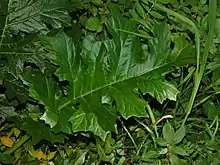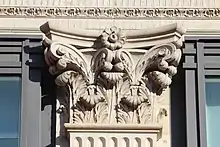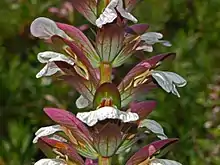Acanthus mollis
Acanthus mollis, commonly known as bear's breeches, sea dock,[2] bear's foot plant, sea holly or oyster plant,[3] is a species of plant in the family Acanthaceae and is native to the Mediterranean region. It is a leafy, clump-forming perennial herb, with a rosette of relatively large, lobed or toothed leaves, and purplish and white flowers on an erect spike.
| Bear's breeches | |
|---|---|
.JPG.webp) | |
| Inflorescence of Acanthus mollis | |
| Scientific classification | |
| Kingdom: | Plantae |
| Clade: | Tracheophytes |
| Clade: | Angiosperms |
| Clade: | Eudicots |
| Clade: | Asterids |
| Order: | Lamiales |
| Family: | Acanthaceae |
| Genus: | Acanthus |
| Species: | A. mollis |
| Binomial name | |
| Acanthus mollis | |
| Synonyms[1] | |


Description
Acanthus mollis is a leafy, clump-forming perennial herb with tuberous roots. It has a basal rosette of dark glossy green, lobed or divided, glabrous leaves 50 cm (20 in) long and 30 cm (12 in) wide on a petiole 20–30 cm (7.9–11.8 in) long. The flowers are borne on an erect spike up to 200 cm (79 in) tall emerging from the leaf rosette. The sepals are purplish and function as the upper and lower lips of the petals, the upper lip about 4 cm (1.6 in) long and the lower lip 3 cm (1.2 in) long. The petals are about 4–4.5 cm (1.6–1.8 in) long and form a tube with a ring of hairs where the stamens are attached. Flowering occurs in summer and the fruit is a sharply-pointed capsule about 2 cm (0.79 in) long containing one or two brown seeds about 14 mm (0.55 in) long and 8 mm (0.31 in) wide.[4][5]
Taxonomy and naming
Acanthus mollis was first formally described in 1753 by Carl Linnaeus in his book Species Plantarum.[6] The name of the genus derives from the Greek name of the plant ἄκανθος ákanthos; it was imitated in Corinthian capitals. This ἄκανθος ákanthos is related to ἄκανθα ákantha meaning "thorn" referring to the thorn-bearing sepals, or any thorny or prickly plant in Greek.[7][8][9][10][11] The Latin name of the species, mollis meaning "soft, smooth", refers to the texture of the leaves.[12]
Ecology
Acanthus mollis is entomophilous, pollinated only by bees or bumble bees large enough to force their way between the upper sepal and the lower, so that they can reach the nectar at the bottom of the tube. Bear's breeches is regarded as invasive in some countries, including Australia and New Zealand.[5][13]
Use in horticulture
These plants are usually propagated from tubers and tend to form large, localized clumps which can survive for several decades and look statuesque when well-grown, but its suitability as a garden plant is lessened on account of its invasive nature (new plants are produced readily both from seed and portions of root) and its susceptibility to attacks from slugs and snails.[14]
Cultural depiction
The shape of the leaf of this plant inspired the ancient Greek sculptor Callimachus (5th c. BCE) to model the capital of the Corinthian column. Since then, the Corinthian order column has been used extensively in Greco-Roman[15] and Classical architecture. For centuries, stone or bronze stylized versions of acanthus leaves have appeared as acanthus decorations on certain styles of architecture and furniture.[16] Virgil described Helen of Troy as wearing a dress embroidered with Acanthus leaves.[17]
Gallery
 Habit
Habit Inflorescence
Inflorescence Close-up of stamens
Close-up of stamens Lateral view
Lateral view Fruit
Fruit Flowering plant in the ruins of the Palatine Hill, Rome
Flowering plant in the ruins of the Palatine Hill, Rome Inflorescence
Inflorescence Fruit and seeds on display at the Muséum de Toulouse
Fruit and seeds on display at the Muséum de Toulouse.jpg.webp) inflorescence
inflorescence Dismembered flower
Dismembered flower
References
- "The Plant List: A Working List of All Plant Species". Retrieved 18 December 2014.
- "Acanthus mollis". Germplasm Resources Information Network (GRIN). Agricultural Research Service (ARS), United States Department of Agriculture (USDA). Retrieved 18 December 2014.
- https://www.weedbusters.org.nz/weed-information/weed-list/bears-breeches/
- Conn, Barry J. "Acanthus mollis". Royal Botanic Garden Sydney. Retrieved 8 October 2020.
- "Acanthus mollis". New Zealand Plant Conservation Network. Retrieved 8 October 2020.
- Linnaeus, Carl (1753). Species Plantarum. Berlin: Junk, 1908. p. 639. Retrieved 8 October 2020.
- ἄκανθος
- ἄκανθα. Liddell, Henry George; Scott, Robert; A Greek–English Lexicon at the Perseus Project
- "άκανθος".
- άκανθος (in Greek). Centre for the Greek Language.
- Harper, Douglas. "acanthus". Online Etymology Dictionary.
- mollis. Charlton T. Lewis and Charles Short. A Latin Dictionary on Perseus Project.
- Weeds of Australia, Biosecurity Queensland edition: Bear's breeches, Acanthus mollis Archived April 2, 2015, at the Wayback Machine
- "Acanthus mollis". Missouri Botanic Garden. Retrieved 8 October 2020.
- and has been described by Vitruvius. On Architecture. Book IV.
- Lewis, Philippa; Darley, Gillian (1986). Dictionary of Ornament. New York: Pantheon. p. not cited.
External links
- The Introduced Flora of Australia and its Weed Status, by R.P.Randall, Department of Agriculture and Food, Western Australia
- Biolib
- Acanthus mollis in the Canary Islands
- Malta Wild Plants
| Wikimedia Commons has media related to Acanthus mollis. |
